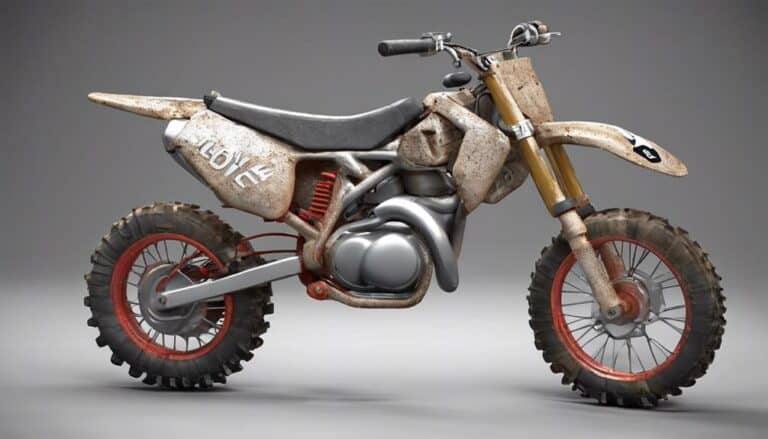You may be wondering if adjusting the oil viscosity in your dirt bike for different riding conditions could optimize performance without compromising engine health.
The answer lies in understanding the intricacies of how various viscosities interact with your bike's components under diverse circumstances.
By exploring the impact of oil grades on your dirt bike's performance in varying terrains and temperatures, you can make informed decisions that enhance both your riding experience and your bike's longevity.
Key Takeaways
- Choose thicker oil for hot weather or heavy loads and thinner oil for cold weather or light riding.
- Following manufacturer's recommendations is crucial for optimal engine protection and performance.
- Adjusting oil viscosity based on riding conditions directly impacts engine efficiency and longevity.
- Proper oil viscosity selection enhances engine response, clutch engagement, and overall dirt bike performance.
Importance of Oil Viscosity in Dirt Bikes
When considering the performance of your dirt bike, the importance of oil viscosity can't be overstated. Motorcycle oil viscosity plays a critical role in providing the best engine protection. The viscosity of the oil determines its thickness and flow characteristics, affecting how well it can lubricate engine components under different riding conditions.
Choosing the right viscosity, whether thick like 20W-50 or thin like 5W-30, is essential for maintaining engine health. Thicker viscosities are suitable for high-temperature environments or when riding with heavy loads, as they offer better protection under these strenuous conditions. On the other hand, thinner viscosities are more appropriate for cold weather or light load riding, ensuring proper lubrication even in such scenarios.
Choosing the Right Oil for Specific Conditions
Selecting the appropriate oil viscosity for specific riding conditions is essential for optimizing engine performance and longevity. When choosing the right oil for your dirt bike, consider the following:
- Thicker oil viscosities like 20W-50 are suitable for hot weather or heavy loads, providing better protection to engine parts under these demanding conditions.
- Thinner oil viscosities such as 5W-30 are ideal for cold weather or light riding conditions, ensuring proper lubrication without causing unnecessary strain on the engine.
- Adhering to manufacturer recommendations is critical as they're tailored to specific engine requirements and riding conditions, promoting ideal performance and longevity.
- Using different oil viscosities for varied riding conditions can enhance engine protection and efficiency, safeguarding crucial components and improving overall dirt bike operation.
Effects of Different Visosities on Performance
Adjusting the oil viscosity in your dirt bike can greatly impact its performance, particularly with regards to engine response and clutch engagement. The thickness of the oil plays a critical role in how well your engine functions under varying conditions. Thicker oil, such as 20W-50, is beneficial for high temperatures as it provides enhanced protection, whereas thinner oils like 5W-30 are advantageous in low temperatures due to improved cold-start performance and flow. When the oil viscosity matches the operating temperature of your engine, it guarantees ideal lubrication and protection. The table below summarizes the effects of different viscosities on performance:
| Oil Viscosity | Performance in High Temperatures | Performance in Low Temperatures |
|---|---|---|
| 20W-50 | Excellent protection | Reduced flow during cold starts |
| 5W-30 | Decreased protection | Improved cold-start performance |
| Manufacturer-Recommended Viscosity | Ideal performance | Ideal performance |
Adjusting your oil viscosity based on the riding conditions can significantly impact your dirt bike's performance and longevity.
Tips for Adjusting Oil Viscosity
For best performance and longevity of your dirt bike, it's essential to carefully consider the appropriate oil viscosity for the prevailing riding conditions. When adjusting the viscosity of the oil, keep the following tips in mind:
- Thicker Oil for Hot Weather: In hot weather or high-stress riding conditions, opt for a thicker oil like 20W-50 to maintain proper lubrication and protection for your engine.
- Thinner Oil for Cold Weather: In colder temperatures, choose a thinner oil such as 5W-30 to guarantee easy startup and adequate lubrication during initial engine operation.
- Consult Owner's Manual: Always refer to your dirt bike's owner's manual for recommended oil viscosities based on temperature ranges to optimize engine performance.
- Impact on Engine Performance: Adjusting oil viscosity based on riding conditions can significantly impact engine performance and longevity, enhancing both protection and efficiency.
Common Myths About Oil Viscosity
Common misconceptions abound regarding the impact of oil viscosity on dirt bike performance. One prevalent myth suggests that thicker oil is always superior for hot conditions, while thinner oil is ideal for cold environments. However, this isn't always the case. In reality, using the manufacturer's recommended oil viscosity is essential for guaranteeing peak engine performance.
Some riders may believe that frequently changing oil viscosity can benefit engine longevity, but this is another misconception. Deviating from the manufacturer's recommendations can actually lead to engine damage and a reduced lifespan for your dirt bike.
It's vital to understand that the manufacturer's guidelines are based on extensive testing and knowledge of the engine's design and requirements. By following these recommendations, you can ensure that your dirt bike operates at its best and remains in top condition for a longer period.
Conclusion
To conclude, always adhere to manufacturer recommendations for oil viscosity in your dirt bike for the best performance and longevity.
By choosing the right oil for specific riding conditions and adjusting viscosity when needed, you can guarantee smooth operation and prevent costly engine repairs.
Remember, proper maintenance is key to maximizing your bike's health and performance.
Stay informed, stay proactive, and ride on with confidence.

